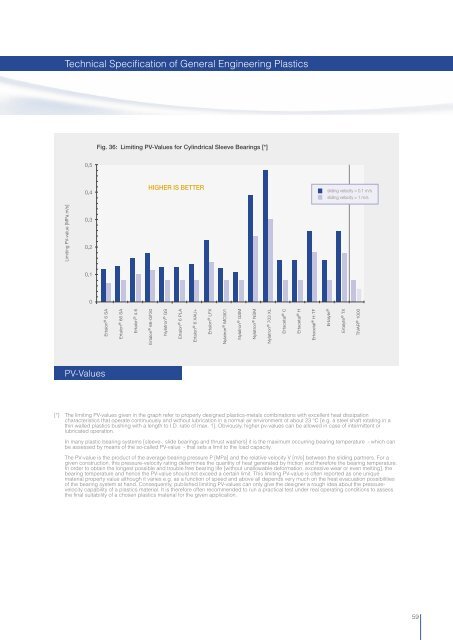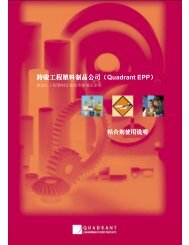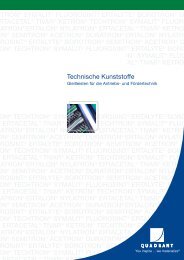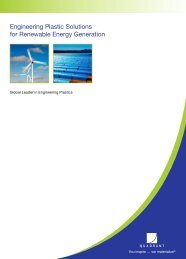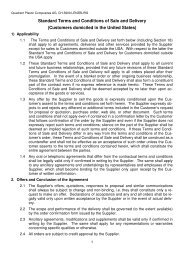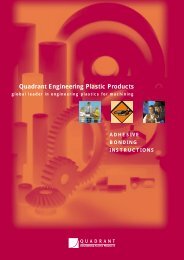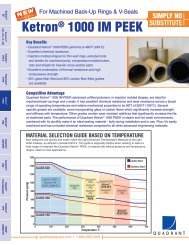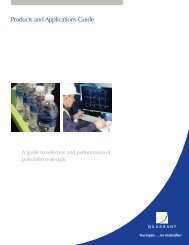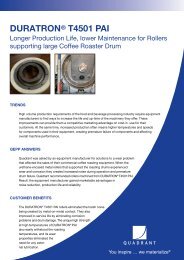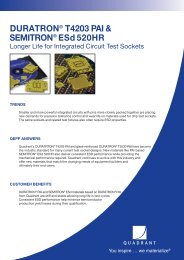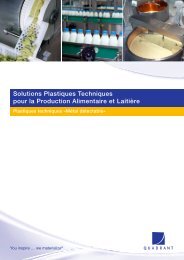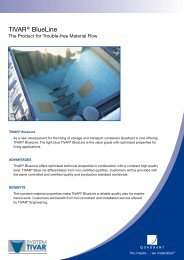Product Guide for Design Engineers - Quadrant
Product Guide for Design Engineers - Quadrant
Product Guide for Design Engineers - Quadrant
Create successful ePaper yourself
Turn your PDF publications into a flip-book with our unique Google optimized e-Paper software.
Technical Specifi cation of General Engineering Plastics<br />
Fig. 36: Limiting PV-Values <strong>for</strong> Cylindrical Sleeve Bearings [*]<br />
0,5<br />
0,4<br />
HIGHER IS BETTER<br />
sliding velocity = 0.1 m/s<br />
sliding velocity = 1 m/s<br />
Limiting PV-value [MPa.m/s]<br />
0,3<br />
0,2<br />
0,1<br />
0<br />
Ertalon ® 6 SA<br />
Ertalon ® 66 SA<br />
Ertalon ® 4.6<br />
Ertalon ® 66-GF30<br />
Nylatron ® GS<br />
Ertalon ® 6 PLA<br />
Ertalon ® 6 XAU+<br />
Ertalon ® LFX<br />
Nylatron ® MC901<br />
Nylatron ® GSM<br />
Nylatron ® NSM<br />
Nylatron ® 703 XL<br />
Ertacetal ® C<br />
Ertacetal ® H<br />
Ertacetal ® H-TF<br />
Ertalyte ®<br />
Ertalyte ® TX<br />
TIVAR ® 1000<br />
PV-Values<br />
[*] The limiting PV-values given in the graph refer to properly designed plastics-metals combinations with excellent heat dissipation<br />
characteristics that operate continuously and without lubrication in a normal air environment of about 23 °C [e.g. a steel shaft rotating in a<br />
thin walled plastics bushing with a length to I.D. ratio of max. 1]. Obviously, higher pv-values can be allowed in case of intermittent or<br />
lubricated operation.<br />
In many plastic bearing systems [sleeve-, slide bearings and thrust washers] it is the maximum occurring bearing temperature - which can<br />
be assessed by means of the so-called PV-value - that sets a limit to the load capacity.<br />
The PV-value is the product of the average bearing pressure P [MPa] and the relative velocity V [m/s] between the sliding partners. For a<br />
given construction, this pressure-velocity rating determines the quantity of heat generated by friction and there<strong>for</strong>e the bearing temperature.<br />
In order to obtain the longest possible and trouble free bearing life [without unallowable de<strong>for</strong>mation, excessive wear or even melting], the<br />
bearing temperature and hence the PV-value should not exceed a certain limit. This limiting PV-value is often reported as one unique<br />
material property value although it varies e.g. as a function of speed and above all depends very much on the heat evacuation possibilities<br />
of the bearing system at hand. Consequently, published limiting PV-values can only give the designer a rough idea about the pressurevelocity<br />
capability of a plastics material. It is there<strong>for</strong>e often recommended to run a practical test under real operating conditions to assess<br />
the fi nal suitability of a chosen plastics material <strong>for</strong> the given application.<br />
59


